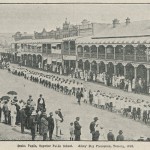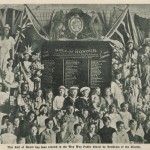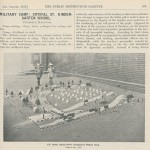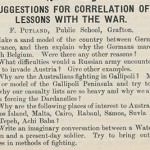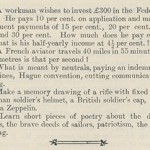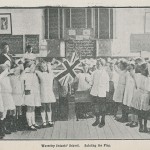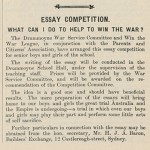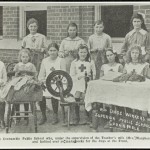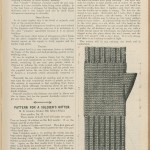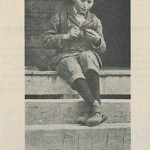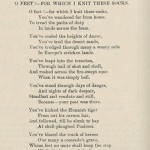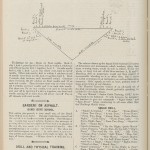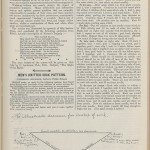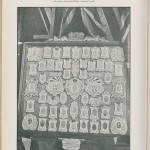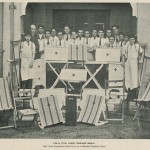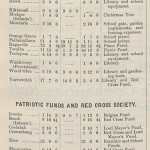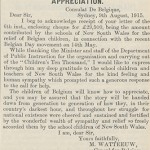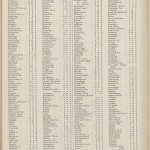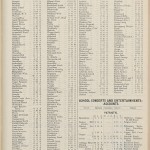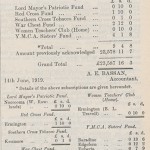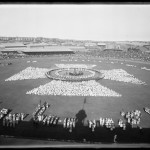Patriotic Fundraising
Public school children help out- [Fig. 1] Allies Day procession featuring Temora school children, 1916. From AK698, Vol. X, No. 9, September 1916, p.295
- [Fig. 2] Roll of Honor, Woy Woy Public School. From AK698, Vol XI, No. 2, February 1917, p.35
The high level of public participation in patriotic fundraising ventures throughout the war years was also reflected in the activities undertaken by public school children in New South Wales. School children were encouraged to become involved in the war effort as a type of war service, inspiring the children to understand and support the ideals of loyalty to Empire, patriotism and sacrifice. (1)
Classroom activities in war
- [Fig. 3] Crystal St Kindergarten creates a military camp. From AK698, Vol. IX No. 8 August 1915, p.209.
- [Fig. 4] Classroom war lessons. From AK698, Vol. IX No. 12 December 1915, p.352
- [Fig. 5] Classroom war lessons. From AK698, Vol. IX No. 12 December 1915, p.353
- [Fig. 6] Waverley Infants’ School saluting the flag. From AK698 Vol.XII No. 4 April 1918, p.76
- [Fig. 7] Essay competition,. From AK698 Vol. XI No. 4 April 1917, p.91
- [Fig. 8] Red Cross workers at Coonamble Public School knitting and spinning, 1918. From NRS 15051.
One way of helping children to understand what was happening on the front line was through lessons and activities in the classroom. Frederick Putland, a teacher from Grafton Public School, published two articles in The Education Gazette, suggesting a variety of ways to introduce war related topics into the curriculum. [Fig. 4-5] Putland’s suggestions covered the fields of maths, comprehension, poetry, modelling, history, geography and patriotism, and included this art activity:
Make a memory drawing of a rifle with fixed bayonet, a German soldier’s helmet, a British soldier’s cap, an aeroplane, a zeppelin. (2)
Crystal St Kindergarten in Sydney recreated a military camp in 1915, with the children making such elements as trees, roads, rivers and railway stations and using their own toys as cars and ambulances. [Fig. 3] Waverley Infants’ School [Fig. 6] included a daily Hymn for our soldiers and saluting the flag practice for students. (3)
In 1917, Drummoyne Public School held an essay competition which was supported by the Drummoyne War Service Committee, Win the War League and the Parents’ & Citizens’ Association. [Fig. 7] The essay question was “What can I do to help win the war?” (4) The New South Wales Recruitment Committee also provided a selection of poems for school children to learn and recite. An example of a suitable recitation poem was The Rendezvous. The first three lines of the poem highlight the obligations and burdens of war:
We have a rendezvous with Duty
The hour is now
The meeting place is by broken town and ruined farm along the torn frontiers of France. (5)
Children were also allowed time off school in approved circumstances to attend patriotic events. Boggabri Public School was allowed to suspend normal school activities to allow the pupils to take part in Allies Day on 17 November 1915. (6) McDonald Central and McDonald Upper Public Schools were sanctioned to close for one day in November 1915 to take part in the welcoming home of returned soldiers. (7) Children from Temora Public School took part in an Allies Day procession in 1916. [Fig. 1]
- [Fig. 9] Knitting pattern for soldier’s mitten. From AK698 Vol. XI No. 5, May 1917, p.121
- [Fig. 10] Boy knitting. From AK698 Vol. XI No. 9 September 1917, p.222
- [Fig. 11] Knitting poem, Knitting 100,000 pairs of socks for our soldiers. From AK698 Vol. XI No. 8 August 1917, p.200
- [Fig. 12] Crows Nest Public School with socks knitted by class, 1917. From NRS 15051
- [Fig. 13] Men’s knitted sock pattern. From AK698 Vol. X No. 7 July 1916, p.242
- [Fig. 14] Men’s knitted sock pattern. From AK698 Vol. X No. 7 July 1916, p.241
Manual work was also encouraged as a type of war service for children. Manual work included activities such as knitting socks [Fig. 12], sewing bags to be used for sandbags in trenches, collecting and recycling materials such as newspapers, or growing vegetables to eat and sell. (8) Knitting was such a popular activity that in 1915 alone, it is estimated that school children in New South Wales knitted about 54,000 pairs of socks. (9) The finished knitted articles were usually donated to the Australian Branch of the Red Cross. [Fig. 8] Knitting patterns for socks and gloves were printed in The Education Gazette [Fig. 9, 13-14], along with a photo of a school boy from Walang Public School [Fig. 10] knitting his first pair of socks for his soldier brother serving in France. (10) A knitting poem, “O Feet! For which I knit these socks”, [Fig. 11] by George Nash, was also published to honour the work of the school children. (11)
Knitting was such a popular past time that wool became scarce by late 1918. Blackfriars Practice School applied for more carded wool to be used as a teaching aid and knitted into socks for distribution to various war funds but could not obtain new supplies of wool locally or through the Education Department. (12)
- [Fig. 15] South Granville Public School, Roll of Honour to include photos. From AK698 Vol. XII No. 9 September 1918, p.244
- [Fig. 16] Albion Street Junior Technical School pupils with Red Cross apparatus they have made. From AK698 Vol. XI No. 4 April 1917, p.88.
- [Fig. 17] Making deck chairs. From AK698 Vol. XII No. 2 February 1918, p.52
Along with knitting, other practical past times were encouraged. Making a Roll of Honour for the school [Fig. 15], along with building deck chairs [Fig. 17], crutches and cupboards to be used by the Australian Red Cross Society [Fig. 16] were common activities. (13) Many public schools grew a variety of vegetables and fruit to be donated to patriotic charities, such as the Gifts in Kind Committee, which in 1918 alone received 595 donations of vegetables from 200 schools. (14)
Patriotic fundraising activities
- [Fig. 18] Public school fundraising summary. From AK698 Vol. IX No. 1 January 1915, p.13
- [Fig. 19] Belgian Children’s Fund Consul’s appreciation. From AK698 Vol. IX No.9 September 1915, p.251
- [Fig. 20] Children’s Ten Thousand campaign report, p.1. From AK698 Vol. X No. 9 September 1916, p.301
- [Fig. 21] Children’s Ten Thousand campaign report, p.2. From AK698 Vol. X No. 9 September 1916, p.301
- [Fig. 22] Children’s Ten Thousand campaign report, p.3. From AK698 Vol. X No. 9 September 1916, p.301
- [Fig. 23] Subscriptions to patriotic funds. From AK698 Vol. XIII No. 7 July 1919, p.163
Early in 1915 the Department of Public Instruction Patriotic Fund was established as a consolidated fund to which all public schools could contribute money from fundraising activities. [Fig.18] Public schools could choose which patriotic group they would like to support, but the major contributions from the fund went to the Lord Mayor’s Patriotic Fund (Sydney), the Red Cross Fund and the National Belgian Relief Fund. (15) In September 1915 the Belgian Consul wrote a thank you letter to the Education Department for their fundraising. [Fig. 19] By February 1915 the Department’s Fund had already donated £1,700 to the Lord Mayor’s Patriotic Fund. (16) Even as late as May 1919 [Fig. 23] small contributions were still being made and the grand total of funds distributed reached £23,587. (17)
School concerts were a popular fundraising activity. Blayney Public School held a concert in 1915 and raised £22 to be divided between new school equipment and the local patriotic fund. (18) Riverstone Public School also held a concert in 1915 and raised £4 11s to go to the National Belgian Relief Fund. (19) Ellalong Public School held a ball on 7 September 1917 and raised £33 for the War Chest Fund. (20)
The Department of Education created the Children’s Ten Thousand campaign to raise £10,000 for the relief of Belgian children. [Fig. 20-22] In 1915 there were nearly 250,000 children enrolled in public schools throughout the state and every public school was encouraged to raise one shilling per head of school population on Empire Day, 24 May 1915. (21) A grand total of £29,500, nearly three times the original target, was finally donated to the Children’s Ten Thousand. (22)
- [Fig. 24] Travelling kitchen fund. From AK698 Vol. IX No. 3 March 1915, p.45
- [Fig. 25] Ambulance donated by the children and teachers of NSW public schools. From AK698 Vol. X No. 2 February 1915, p.57
The Department of Education staff created the Travelling Kitchen and Motor Ambulance Fund in 1914. [Fig. 24] Early in 1915 the fund purchased a field kitchen for the 18th Infantry Battalion. The fund also donated £500 for the purchase of an ambulance to transport Australian Imperial Force soldiers in London [Fig. 25], suitably emblazoned with “Presented by the Children & Teachers, Public Schools, New South Wales”. (23)
Patriotic groups in schools
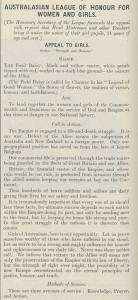
[Fig. 26] Australasian League of Honour for women and girls. From AK698 Vol. IX No. 8 August 1915, p.210
Girls of Australasia, here is our opportunity. Let us prove ourselves worthy of those who have suffered in our stead. (24)
References to a number of other patriotic groups that operated in schools can be found in NRS 3829 School files . School records include letters from groups like the Junior Red Cross Society (established in Sydney schools in 1914 and Australia wide in 1918), Girl Aids or the League of Girl Aids and the Glebe Girls’ Patriotic Club. Often these types of groups were allowed to hold meeting in public schools, like the Girl Aids learning first aid at Sydney Girls High School. (25) The Defence Act 1910 established a Commonwealth Cadet Corps in schools, also making service in this Junior Cadets compulsory for all boys aged 14-18 and who were deemed medically fit. (26)
Patriotic Displays
- [Fig. 27] School children display of Australia with Red Cross in centre, July 1915. From NRS 4481 ST5705P.
- [Fig. 28] Children’s patriotic display, England, October 1914. From NRS 4481 ST5600P.
- [Fig. 29] Children’s display of Victoria Cross, September 1916. From NRS 4481 ST5892P.
One way for schools to raise money for patriotic causes in the wider community was to provide entertainment in the form of patriotic displays. Sydney school children took part in several patriotic displays during the war years. The first display was on 14 October 1914 at the Sydney Cricket Ground [Fig. 28] and over 10,000 children dressed up as the Allied nations, such as France, Great Britain, Belgium and Japan. The highlight of the display involved the creation of a living Union Jack flag. The display was so successful it was repeated in the following week. (27) School children also participated in the Australia Day/Red Cross fundraising in July 1915. [Fig. 27] Another display was put on later in the war by the Public Schools Amateur Athletic Association on 9 September 1916. [Fig. 29] This display featured dancing, gymnastic marches, pennon flag drills and the creation of a Victoria Cross. Half the proceeds for the day were donated to the Belgian Children’s’ Relief Fund. (28)
Links
- Back to Patriotic Fundraising Introduction
- Run by women for women: the role of women in patriotic fundraising
- Australian Branch of the British Red Cross (Coming Soon!)
References
(1) McKernan, Michael, The Australian People and the Great War, Sydney, Collins, 1984, pp.43-63.
(2) New South Wales State Archives: Department of Education; AK698 The Education Gazette, Vol. IX, No. 12, December 1915, p.353.
(3) AK698 The Education Gazette, Vol. XII, No.4, April 1918, p.76.
(4) AK698 The Education Gazette, Vol XI, No. 4, April 1917, p.91.
(5) AK698 The Education Gazette, Vol.XII, No.11, November, p.282.
(6) NSWSA: Department of Education; NRS 3859 Copies of letters sent concerning staff and general matters, [1/2102] letter 1915/100901.
(7) Ibid., 1/2102, 18 November 1915, p.26.
(8) Department of Veteran Affairs, “Schooling Service and the Great War – How did the Great War affect daily life in schools?” leaflet, http://www.anzacportal.dva.gov.au/sites/default/files/publication-attachments/SSGW_Primary_Part1_0.pdf, accessed 3 May 2015.
(9) Oppenheimer, Melania, Australian Women and War, Canberra, Department of Veteran Affairs, 2008, p.42.
(10) AK698 The Education Gazette, Vol. XI, No. 9, September 1917, p.222.
(11) AK698 The Education Gazette, Vol. XI No. 8, August 1917, p.200.
(12) NSWSA: Department of Education; NRS 3829 School files, Blackfriars [5/14948B] 22 October 1918.
(13) AK698 The Education Gazette, Vol.X, No.3, March 1916, p.84.
(14) AK698 The Education Gazette, Vol.XIII, No.1, January 1919, pp.35-36.
(15) AK698 The Education Gazette, Vol.IX, No.2, February 1915, p.31.
(16) Ibid.
(17) AK698 The Education Gazette, Vol.XIII, No.7, July 1919, p.163.
(18) AK698 The Education Gazette, Vol.IX, No.2, February 1915, pp.32-33.
(19) Ibid.
(20) NSWSA: Colonial Secretary; Main series of letters received [5/7540] 17/55762.
(21) “Empire Day Celebrations The Children’s Ten Thousand”, Nepean Times, 22 May 1915, http://trove.nla.gov.au/ndp/del/article/86172236.
(22) AK698 The Education Gazette, Vol.IX, No.9, September 1915, p.251.
(23) AK698 The Education Gazette, Vol.X, No.6, June 1916, p.153 & Vol.X, No.10, October 1916, p.57.
(24) AK698 The Education Gazette, Vol. IX, No.8, August 1915, p.210.
(25) NRS 3829 Sydney Girls High [5/17745.1, 5/17746.1].
(26) Guide to the Cadets Souvenir Collection, Australian War Memorial, https://www.awm.gov.au/findingaids/special/Souvenirs/cadets.xml, access on 3 May 2015.
(27) “The Grand Union”, Sydney Morning Herald, 15 Oct 1914, p.5, http://trove.nla.gov.au/ndp/del/article/15547225.
(28) “Children’s Day”, Sydney Morning Herald, 11 Sept 1916, p.6, http://trove.nla.gov.au/ndp/del/page/1268714.

